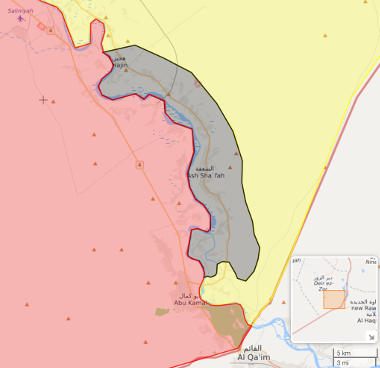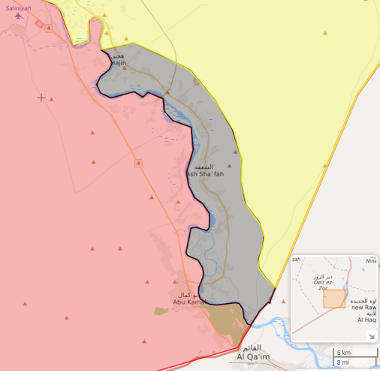By Moon Of Alabama
October 30, 2018 "Information Clearing House" - The U.S. backed proxy force in east Syria again lost positions to the Islamic State.
The map shows the positions of ISIS (grey), the US. proxy force SDF (yellow) and the Syrian army (read) at the border with Iraq on October 19.

bigger
Here are the positions as of today.

bigger
The U.S. proxy force lost the towns Susah, Hawi al-Susah, Safafinah, Mozan, Shajlah and Baghuz Fawqani and ISIS is back at the Iraqi border. The Iraqi forces were alarmed and sealed the border on their side.
|
Are You Tired Of The Lies And Non-Stop Propaganda? |
The immediate cause of the loss was another sandstorm which ISIS used to counterattack. A similar counterattack during a sandstorm happened two weeks ago. That makes this U.S. spokesman's statement laughable:
“The sandstorm allowed an ISIS counterattack, which was surprising given the conditions, but now the air is clear and the Coalition will continue to increase air and fire support to assist our partners,” Col. Ryan said ...
Sandstorms disable air and artillery support. That is why ISIS, which lacks an airforce, has for years used each and every sandstorms to attack. That is not surprising at all, but one of its signature form of fighting. Sandstorms mean that one can expect an ISIS attack. That one has to double ones guard and be ready to defend ones position. The U.S. special forces who are supposed to lead their proxies seem to have neglected that.
ISIS jihadis attacked during the sandstorm in their usual manner. A suicide bomber blew up the first position at the frontline and more than 100 fighters stormed through and rolled up their enemies lines. Since Friday some 60 to 80 SDF were killed, more were wounded and at least 20 were taken prisoners. Others simply fled in panic and ISIS could recaptures several villages without a fight. ISIS claims that all the captured fighters were Arabs, not Kurds.
The Kurds decided long ago that the fight at the Euphrates is not their main problem. They prepare to fight against a Turkish invasion. The SDF ground force attacking ISIS is mostly Arab. Some were hired by the U.S., but many of them were pressed into service. They are not that interested in risking their life. They will only attack after the U.S. air force bombed their enemies to smithereens.
After the high losses of the Arab SDF the Kurdish YPG was told to sends some 300 of its fighters to regain the lost positions and to continue the general attack on ISIS which for month yielded no gains.
ISIS still holds some 700 prisoners and hostages. It had threatened to kill them if it does not receive food and medical supplies. There has been no news of their fate.
On Friday the presidents of Russia, France
and Turkey and the German chancellor Merkel
met in Istanbul. The French and German sides
have given up on regime change. They have a
refugee problem and want the war to wind
down. They still insist that Syria should
change its constitution but Damascus has no
reason to follow such calls. The former
Indian ambassador to Turkey, MK Bhadrakumar,
has a
deeper analysis of the summit. The big
question to him is how the Turkish-American
relations evolve.
There is little reason to think that these will get better. Erdogan wants the U.S. out of Syria nearly as much as Damascus itself. Erdogan threatened recently to invade the northeastern part of Syria that the U.S. controls. Yesterday Turkish artillery hit positions of the U.S. proxy force in Syria near the border with Turkey.
The U.S. keeps insisting that 'Iran-backed militias' leave Syria before the U.S. leaves. But the 'Iran-backed militias' in Syria are nowadays Syrians. Iran supported groups with Afghan and Iraqi fighters and Iranian soldiers have left the country some time ago. There are at most some Iranian officers left who train local groups which Iran has put on its payroll. The demand makes no sense. It likely originates from Israel which wants the U.S. to stay in Syria as long as possible.
The situation in Idelb governorate and elsewhere has not changed. The upcoming U.S.-Russia summit on November 11 will discuss the Syria issue. Until then everything is on hold.
This article was originally published by "Moon Of Alabama" -
Do you agree or disagree? Post your comment here.
==See Also==
Note To ICH Community
We ask that you assist us in dissemination of the article published by ICH to your social media accounts and post links to the article from other websites.
Thank you for your support.
Peace and joy

